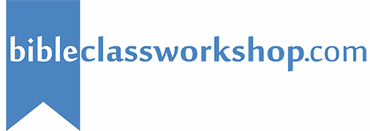The Best Equipment to Get the Job Done
A well-equipped resource room needs several pieces of equipment. Here are the things we recommend…and the why behind each! Of course, it is not always possible to start with everything so consider this a priority list as well.
Laminator- 27” school grade
A laminator should be considered an absolute necessity for this work. A congregation will spend a great deal of money purchasing ready-made visuals and a great deal of time creating visuals. It is a shame and a waste when those materials are not protected. Buying the machine is a financial investment, but as laminated materials last many years longer than unlaminated materials, buying a laminator is a sound financial decision.
Some will ask why not save money by buying a smaller and cheaper machine. You can. But then you are limited to laminating smaller materials. A 27” wide roll laminator will allow you to laminate posterboard size visuals.
Recommendations: The Banner Easy-Lam (or Easy-Lam II) 27 in. Roll Laminator is a workhorse that stands up to years of use. But when it was time for the workshop to purchase, we chose the GBC Ultima 65. It has multiple speeds which allows better laminating for a wider variety of materials, buttons to select heat for specific thicknesses of laminating film, and is easier to feed materials smoothly. It also runs indefinitely without having to wait for the machine to reheat.
Table or cart for laminator:
Placing the laminator at one end of a sturdy table allows the laminated materials somewhere to lie flat after they exit the machine. However, that means the machine cannot be easily moved. A cart made specifically for the laminator allows for portability and frees up valuable table space.
Copier- laser monochrome
Teachers need to be able to copy materials to create visuals or for classroom use. Often it is possible to use a copy machine in the "church office.” However, having a copier in the resource room will save a lot of time and will cut down on traffic in an area where other things may be going on.
The ideal copier will be able to handle up to 80 lb. paper to allow for copying on cover weight Astrobrite paper. Ideal comes with a bigger price tag so you'll have to make a budget/need decision.
Bookshelf
A good resource room is a library of visuals—and books! Pattern books, picture books, and reference books all have their place in a resource room. A simple bookshelf will make storing these books easy and will help protect them from damage that can come from just being stacked somewhere.
Projector
Overhead and opaque projectors have given way to data projectors. Use this to shine a computerized picture on the wall, enlarge it, and trace it. A cheaper option is a tabletop art projector. We do not recommend the inexpensive "craft projectors,” but the Artograph Prism might be a good option.
Suggestion: Look for a projector that allows you to place a book or small 3D object flat on the glass. Models that sit on the artwork or attach artwork to the lid are not as desirable. Also note the strength of the lighting. The stronger the bulb, the easier it will be to trace the art.
Small parts/utility drawer
This is simply a plastic box with a variety of drawers in it; fishermen often use something like this to keep lures and such. It is perfect for storing brads, paper clips, and many other small items a resource room needs to stock.
Paper cutter
A paper cutter saves wear and tear on the hands as you create visuals. Use one to cut the big paper down to a size that goes through your copier or to trim booklets, etc.
Although larger sizes are available, our experience indicates that a 12” cutter is sufficient.
Other equipment to add as the room grows:
Computer (newest system is not necessary, but a discrete graphics card & large hard drive are important)
Software for creating visuals (Adobe Photoshop; Paint.net; Microsoft Publisher; OpenOffice Draw; Affinity software) and keeping records (Microsoft Access; Zoho Creator; Google Docs)
Color printer (A good inkjet can be purchased for $150 or less; if you want a more usable model, choose one that will handle 11 x 17 cover weight paper - that cost is $350 or more; best option is a color laser that handles the cover weight paper = that cost is around $3,000. We use and recommend the Ricoh Aficio Sp series.)
Scanner (or phone with scanning app)
Rack for bulletin board paper - Wall-mounted or rolling.
Ellison machine for letters (Some congregations make good use of these; we prefer doing lettering on the computer so we can vary size, font, etc. without having to purchase more dies. This method saves money, too. )
Silhouette Cameo or Cricut cutter (low priority but a really nice addition!)
